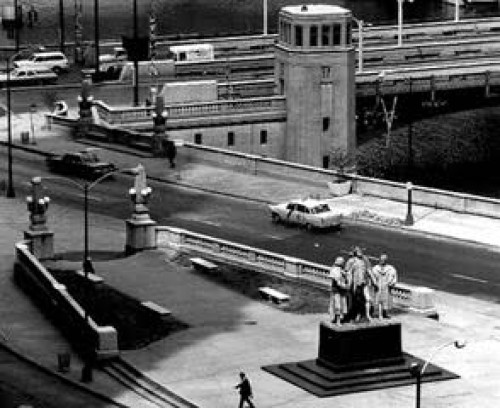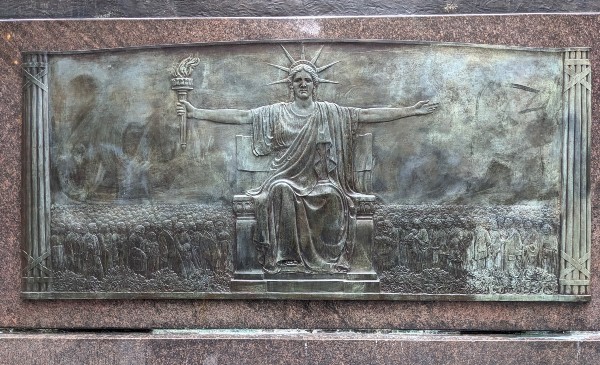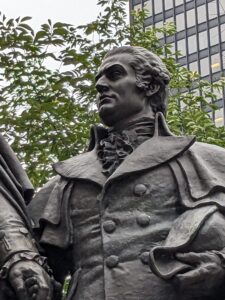by Tom Carmichael, class of 2007 and Jill Tanz, class of 2003
On first encounter, the Heald Square Monument presents more questions than answers. Where is Heald Square? Who are the men holding hands with George Washington? And why is there a large plaque on the back? The monument is a remarkable memorial to the American Revolution, particularly the unity of Christians and Jews in their patriotism and sacrifice. It is also a monument to the importance of finance in the Revolution and the role that immigrants have played in the creation of the United States.

Heald Square
Heald Square no longer exists. It was named after Nathan Heald who was commander at Fort Dearborn in 1812. Heald Square was a roughly triangular-shaped traffic island in the middle of Wacker Drive between Wabash Ave. and State St. In addition to the statue, Heald Square was the location of the city’s initial memorial for veterans of the Vietnam War. According to Blair Kamin, the location “had all of the serenity of a drag strip.” When the city widened Wacker Dr. in the early 2000’s, both the monument and the Vietnam Memorial plaques were moved to the riverbank near Wabash Ave.


The Financiers the American Revolution
The men on either side of George Washington are two of the key figures who made possible America’s victory over the British. Robert Morris (1734 – 1806), standing to Washington’s right, was a signer of the Declaration of Independence and the Superintendent for Finance for the Thirteen Colonies. Haym Salomon (1740 – 1785), on Washington’s left, was a Polish-born Jewish financier. He brokered most of the sale of financial aid to the Colonies from France and the Dutch Republic by selling bills of exchange to American merchants. In 1781, when the Continental Army cornered General Cornwallis and his British troops in Yorktown, Virginia, George Washington wanted to march his troops from New York to Virginia to bring the war to an end. However, Washington had no money to finance another campaign nor did Congress have any funds. Washington told Morris he needed $20,000. Morris turned to Salomon who raised the $20,000.
Creation of the Monument
Honoring Haym Salomon was the life-long dream of Barnet Hodes, a prominent attorney with Jewish-Polish roots. In 1936, Hodes formed the Patriotic Foundation of Chicago to raise funds for the monument. He worked with Lorado Taft on the design and invited a religiously and ethnically diverse group to join the Patriotic Foundation and raise the money needed to erect the monument.
Hodges wanted to fight rising anti-Semitism in the U.S. and Europe by showing that Christians and Jews worked together to support the Revolutionary War. He also wanted to show that it took civilian as well as military might to win the war. George Washington symbolized military power while Robert Morris and Haym Salomon were the civilians who financed the fledgling country.
The monument was officially dedicated on December 15, 1941. The date was chosen to be part of the celebration for the 150th anniversary of the Bill of Rights. The date turned out to be just eight days after Pearl Harbor and the entrance of the U.S. into World War II. The message of anti-Semitism and tolerance was even more important in this historical context.
Lady Liberty Plaque
On the rear of the monument is a 9 ft. by 4 ft. plaque featuring Lady Liberty seated with arms outstretched to the immigrants entering the U.S. This plaque makes clear that the memorial goes beyond the fight against anti-Semitism and also includes tolerance and cooperation among all the immigrant groups coming to America.

Riches to Rags
Unfortunately, the stories of our two heroes, standing on either side of Washington, do not have happy endings. At the start of the Revolution, both were very wealthy. Robert Morris was said to have been the richest man in the Thirteen Colonies. Salomon had made a fortune as a financier. Salomon loaned much of his wealth to the Revolutionary forces and individuals supporting the war. They never repaid him. He died suddenly at the age of 45 in poverty. His remains are buried in the Mikveh Israel Cemetery in Philadelphia. Although his grave is unmarked, a plaque at the entrance to the cemetery honors his memory.
Robert Morris died at 72, also in poverty. After a long series of money-losing, land speculation deals, Morris was forced into debtor’s prison in the late 1790s. He died penniless and is buried in his brother-in-law’s vault in the churchyard of Philadelphia’s Christ Church, only a mile from Salomon’s grave.
Today the Heald Square Monument honors the spirit of unity among the people of the United States – the spirit of diverse individuals coming together from different faiths and parts of the world to support our country in its hours of need.
____________________________________________________________________________

CLICK HERE for more stories on The Bridge.






Great story of an often forgotten monument dedicated to two individuals who played a very important role financing independence of the USA.
Thanks for the backstory for the monument that everyone passes at one time or another but no one ever remembers its history.
Thank you for researching and sharing this important story, Tom!
Excellent article! Thank you!
I love telling this special story on Icons. Thanks for sharing it. Jill C
Thanks for this detailed write-up and pictures, too!
Excellent backstory! Thank you both!
Thanks for this detailed and interesting information!